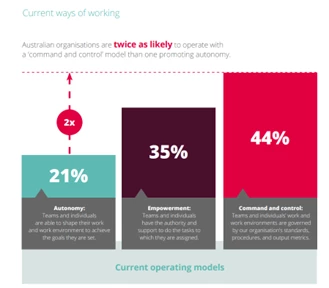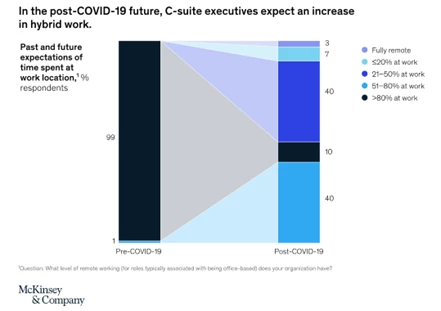
Some people loved it, while others loathed it. But for most, it was just the way things were, everyone got used to it, and now lots of people never want to work from an office ever again.
However, one thing didn’t change – people missed other people. They missed the connections they had with co-workers. The collaboration and the water cooler chatter. People missed gossiping with their work bestie while waiting for a coffee and being able to pop into someone’s office for a second opinion.
So, as we move into the new normal, how will organisations continue to manage connections in a disconnected world?
Hybrid working is here to stay
As the world moves into the post-pandemic period, businesses now want employees to come back into the office – and they’re realising some people aren’t keen to go back to the way things were. For a start, after two and a half years of working outside an office environment, they’ve become pretty autonomous.
In fact, this shift was so momentous, The Access Group surveyed a group of Australian professionals for our August 2021, Autonomy to the People report. We learned that workplace autonomy is relatively rare, and the leaders and managers we surveyed used a mix of empowerment and top-down control. We also discovered they’re twice as likely to operate with a ‘command and control’ model than one promoting autonomy.

Source: The Access Group Autonomy to the People (2021) report
Its clear leadership and management styles will need to adapt because hybrid working is here to stay. A 2021 McKinsey article, What executives are saying about the future of hybrid work suggested that in a post-pandemic world, nine out of ten organisations will combine some form of hybrid working. The article notes:
‘Despite the embrace of a hybrid model, though, most organisations have only begun to think through and articulate the specifics of how to carry out a more permanent mix of remote and on-site working for all roles that aren’t essential to perform on-site. Many of their employees are feeling anxious as a result.’

Source: What executives are saying about the future of hybrid work – McKinsey
With surveys, such as the one conducted by McKinsey, and anecdotal evidence supporting increased productivity with people working remotely, the onus it seems will fall to businesses to find ways to build employee connections. And while there is no denying it will be hard; the benefits far outweigh the challenges.
Benefits of connection
Human beings are wired for connection, as noted by scientist and author Matthew Lieberman when he spoke to Scientific American for the article Why we are wired to connect. Liebermann argued the human need to connect is as fundamental as the need for food and water.
But is this need to connect important in the workplace? All evidence suggests that yes, it is.
When Blueboard questioned 400 HR (Human Resources) professionals and 500 employees about their views on workplace connection for their State of Workplace Connection Report 2022, they discovered people want to feel connected at work. According to the report:
’85% of HR professionals strongly agree it’s important for employees to feel connected at work, and 77% of employees agree they want to work at an organisation where they feel connected to the purpose and the people.’
The report also said nearly 60% of employees would consider leaving their job if they didn’t feel connected at work. Additionally, 95% of HR leaders and professionals acknowledge employee connection is critical for employee retention and the overall success of their organisation.
With businesses continuing to struggle with staff shortages well into 2022, in some part as a result of The Great Resignation, they need to seriously consider how technology can help their employees stay engaged and connected.
The technology your employees need to keep them connected
Technology is all around us. We use it in our everyday lives to build and maintain connections. And the workplace is no different, especially with hybrid and remote working here to stay. So, what do your employees want in their workplace tech to help them stay engaged and connected?
- Easy to use – not everyone is as tech-savvy as Gen Z, so find tech that’s easy to use for everyone.
- Minimal downtime – there’s a reason why Microsoft Teams are one of the world’s most popular apps. When Teams goes down, it makes the news!
- Easy access – can the tech be easily downloaded, installed, and accessed from any device?
- Tailored experience – for example, can the tech be used in dark mode? People want the flexibility to set up apps to suit their own needs.
- Lots of functions – nobody wants to download a zillion different apps, so look for apps that do many things.
- Chat function – is there somewhere your people can have their water cooler chats virtually?
Something we can all agree on
The one thing employers and employees agree on is the need to integrate technologies where possible because having endless programs open is distracting, annoying and counterproductive. Luckily, The Access Group has the solution.
Access Definitiv is a flexible, single-platform, cloud-based payroll and workforce management system which will revolutionise the way you manage and connect with your people. Wherever your people are located – in the office, out on site, or even abroad – they’ll be able to access your business’s workforce management system anywhere they have an internet connection and on any device.
Book a Definitiv demo, or download The Connected Workforce eBook today and learn just how easy it can be to keep your people connected.